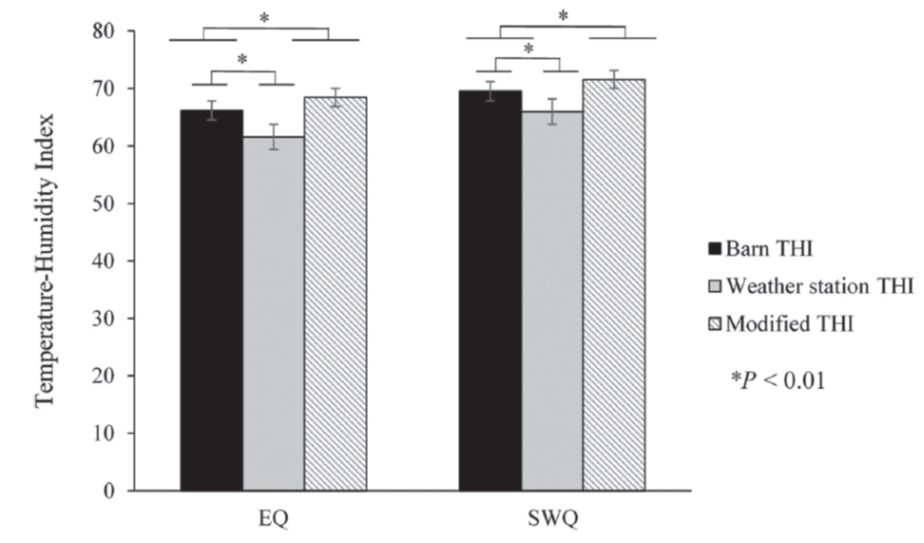Articles scientifiques

- Date de publication : 2019-05-31
Référence
Ouellet, V., Bellavance, A. L., Fournel, S., & Charbonneau, E. (2019). Short communication: Summer on-farm environmental condition assessments in Québec tiestall farms and adaptation of temperature-humidity index calculated with local meteorological data. Journal of Dairy Science 102(8): 7503-7508.
Documents
Information Complémentaire
https://www.sciencedirect.com/science/article/pii/S0022030219304631
Mot(s) Clé(s)
Lait Environnement
Résumé
Temperature-humidity index (THI) calculation following the equation developed by the National Research Council (A Guide to Environmental Research on Animals, 1971) requires ambient temperature (AT) and relative humidity (RH). Those data are widely and readily available at local meteorological stations. However, studies showed that using average AT and RH retrieved from the closest stations is not appropriate for estimating on-farm conditions. The present objectives were (1) to study summer on-farm environmental conditions, (2) to explore the relationship between summer THI calculated with on-farm data and summer THI calculated with local weather station data, and (3) to verify whether THI calculated with summer meteorological station data could be adapted to better represent summer on-farm conditions. Six tiestall dairy farms located in 2 regions of the province of Québec [Eastern Québec (EQ) and Southwestern Québec (SWQ)] were enrolled in this study. Within-barn conditions were monitored using 3 remote data loggers from August 2016 through August 2017. Two loggers were installed inside at varying distances relative to the ventilation inlet (L1: closest to inlet; L2: farthest from inlet) and a third was installed just outside of the barn (L3). Values retrieved from each logger and the closest local meteorological station were used to calculate daily THI according to the National Research Council formula and were ultimately compared. Our results showed that THI varied within the barn depending on the proximity relative to the inlet because THI measured by L1 was lower than THI measured by L2 in both regions. Moreover, our results showed that in both regions AT measured on-farm was consistently higher than AT measured at the weather station. The opposite was observed with RH, as it was significantly lower on-farm in EQ and numerically lower in SWQ compared with RH extracted from weather stations. Overall, this led to THI being lower by 4.6 and 3.7 units at the weather stations compared with within-barn conditions for EQ and SWQ farms, respectively. Hence, using local meteorological station data to estimate on-farm conditions would lead to an underestimation of heat stress level in dairy cows. Adapting THI calculations by including daily maximum AT and minimum RH retrieved from the local weather station instead of their average counterparts led to a better estimation of within-barn conditions. However, the difference between THI measured on-farm and the adapted THI calculated with weather station data remained significant. Although the adaption made to THI allowed for a closer relation to on-farm conditions, THI calculated with weather station data should only be used to assess heat stress level in dairy cows when heat stress thresholds are adapted for such data.


